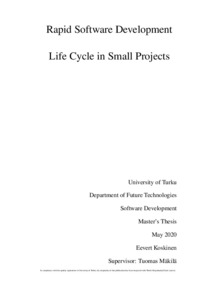Rapid Software Development Life Cycle in Small Projects
Koskinen, Eevert (2020-05-12)
Rapid Software Development Life Cycle in Small Projects
Koskinen, Eevert
(12.05.2020)
Julkaisu on tekijänoikeussäännösten alainen. Teosta voi lukea ja tulostaa henkilökohtaista käyttöä varten. Käyttö kaupallisiin tarkoituksiin on kielletty.
avoin
Julkaisun pysyvä osoite on:
https://urn.fi/URN:NBN:fi-fe2020052539006
https://urn.fi/URN:NBN:fi-fe2020052539006
Tiivistelmä
Small software projects are becoming more usual nowadays. Whether a small project is
conducted privately or professionally, the management of the project and its phases is
much easier with proper tools and frameworks. The research target of this thesis is to
find out a proper life cycle model for small software projects.
This thesis is conducted for Softwarehouse, a professional division of IT services in
the University of Turku. The official guide for Scrum framework is adhered in software
development but when it comes to formally managing various phases of a software
project (planning, design, implementation, testing, reviewing etc.) there is room for
improvement. Managing software projects with a proper set of tools and procedures
would be beneficial as Softwarehouse works on many projects concurrently.
The intended life cycle model has to be formal and heavy enough so that the
benefits of agile project management can be received. However too rigid a model can
be too arduous and exhausting to use, which could result in the decrease of
Softwarehouse’s production volume. Therefore the model has to be light enough to
maintain rapid software development and creative atmosphere within the
Softwarehouse. This thesis begins by giving outline of existing software development
life cycle models and followed by relevant literary exploration. After this the research
case is explained in greater detail. These give the foundation and rationale to propose a
suitable model. The model is experimented empirically and reviewed by partaking
personnel. The results are reviewed and discussed. Finally topics for future research are
suggested.
conducted privately or professionally, the management of the project and its phases is
much easier with proper tools and frameworks. The research target of this thesis is to
find out a proper life cycle model for small software projects.
This thesis is conducted for Softwarehouse, a professional division of IT services in
the University of Turku. The official guide for Scrum framework is adhered in software
development but when it comes to formally managing various phases of a software
project (planning, design, implementation, testing, reviewing etc.) there is room for
improvement. Managing software projects with a proper set of tools and procedures
would be beneficial as Softwarehouse works on many projects concurrently.
The intended life cycle model has to be formal and heavy enough so that the
benefits of agile project management can be received. However too rigid a model can
be too arduous and exhausting to use, which could result in the decrease of
Softwarehouse’s production volume. Therefore the model has to be light enough to
maintain rapid software development and creative atmosphere within the
Softwarehouse. This thesis begins by giving outline of existing software development
life cycle models and followed by relevant literary exploration. After this the research
case is explained in greater detail. These give the foundation and rationale to propose a
suitable model. The model is experimented empirically and reviewed by partaking
personnel. The results are reviewed and discussed. Finally topics for future research are
suggested.
